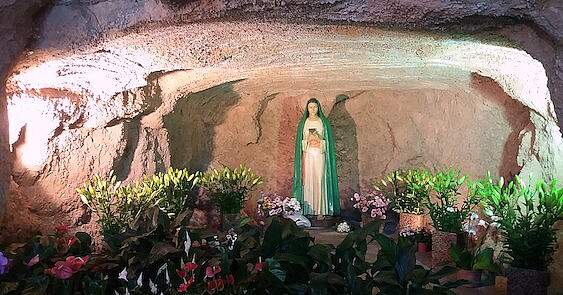
Bruno Cornacchiola, an anti-clerical Protestant, had every intention to murder Pope Pius XII — until the Virgin Mary interfered April 12, 1947, at Tre Fontane (“Three Fountains”). Cornacchiola was enjoying a day at the park with his three children. He was preparing a vulgar speech denying the Virgin Mary’s existence for his role in the local Seventh-day Adventist Protestant community.
When he realized his children’s voices were becoming faint and went to search for them, he found his children kneeling like marble statues in front of the grotto, repeating the words “Beautiful lady.” Shortly after, Cornacchiola was able to see the Virgin, who was dressed in white, wearing a green mantle with a pink band, and holding the Scriptures.
“I am the Virgin of the Revelation. You are persecuting me — enough of it now!” she told him. “Enter into the sheepfold, the holy court of heaven on earth.” Our Lady also gave a heavenly sign to Pope Pius XII through Cornacchiola, who was asking for confirmation on how to clearly define the dogma of the Assumption in light of his encyclical issued Nov. 1, 1950. “My body could not decay and did not decay. My Son and the angels took me to heaven,” were the words from the Virgin given to Cornacchiola for the Holy Father.
He carried this message to the Vatican. During his audience with Pius, Cornacchiola asked for forgiveness for his hatred against the Catholic Church after his conversion to Protestantism. This is what led him to plot against killing the Pope. He confessed to Pius that he even bought a dagger with the inscription “death to the pope.”
Cornacchiola’s reconversion launched his entrance into the “sheepfold,” the Catholic Church. His conversion was lasting, and he evangelized for the Church until his death in 2001. His two sons continue to tell his story.
Several stages have been taken toward planning a new sanctuary, since the Diocese of Rome bought the ground on which the grotto is located. At the shrine, two Masses are said each weekday, with five Masses every Sunday. Pilgrims from all over the world come to receive the graces that have been proven to be granted there. The first miracle happened two months after the apparition to Carlo Mancuso, who fell from an elevator shaft and received countless injuries in his arm and pelvis. After contact with the soil from the grotto, he was able to walk again, despite the x-rays still showing fractures in his body.
The holy atmosphere is a stark contrast to which Tre Fontane was originally known.
“The grotto of Tre Fontane was a place of ‘sin’ because it was a place of illicit meetings and also where the remains of aborted children were found. Therefore, Our Lady said, ‘With this soil of sin, I will work great miracles for the conversion of unbelievers and sinners,’” explained Sister Emanuela Edwards, a Missionary of Divine Revelation.
Behind the grotto there is a small corridor with a collection of photos, flowers, mementos and a carved plaque, left in gratitude to the Virgin. Toward the end of the corridor is the heart of the grotto, which marks the exact place the Virgin Mary disappeared from Cornacchiola, turning in the same direction as St. Peter’s Basilica. The converted man prayed there often to ask for particular intercessions.
The Marian apparition at Tre Fontane was informally approved by Pope Pius XII on October 5, 1947, when he blessed the Virgin of Revelation statue with a procession from the Vatican to the grotto and gave permission for Cornacchiola to speak about the apparition. Steps toward official approval are underway but have not yet been completed.
The Missionaries of Divine Revelation dedicate their lives to spreading the message of the “three white loves” that the Virgin of Revelation revealed in her apparition: the Eucharist, the Immaculate Virgin Mary and the Holy Father.
Source: National Catholic Register